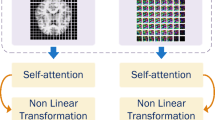Abstract
The traditional medical image recognition methods are limited by image resolution, image brightness and color processing parameters, and image quality evaluation is low. In particular, the incomplete visual information of medical images and the disorder of color structure make the complexity of human visual perception and recognition significantly increased and the accuracy is poor. In order to solve the above problems, this paper is based on the mechanism of deep brain information perception and dementia induced brain magnetic resonance imaging (BMI-DVDI). On the one hand, based on the depth fusion of the visual information system, the medical image depth vision system and its perception model with high precision and low complexity are designed for the two damage of medical image quality and the perception of visual information. On the other hand, the dementia model is designed by means of matrix representation of dementia image signal, screening of dementia sensing brain signal and image reconstruction. The model is helpful to solve the problems of image signal deformation, measurement precision of signal degree and reconstruction of image enhancement in brain magnetic resonance imaging. This model enhances the accuracy of brain diseases such as dementia. Then, we combine the sensing algorithm with the degree of dementia in the brain, and apply it to the MRI of the brain. Finally, through simulation experiments and nuclear magnetic resonance imaging experiments, the space complexity, time complexity, system execution efficiency and image quality evaluation are compared. The result is that the proposed algorithm has excellent performance.









Similar content being viewed by others
References
Buckberg GD, Mahajan A, Jung B et al (2016) MRI myocardial motion and fiber tracking: a confirmation of knowledge from different imaging modalities.[J]. Eur J Cardio-Thoracic Surg 29(Suppl 1(Supplement_1)):423–430
Jie Y, Daojun T (2018) A modified improved Possibilistic c-means method for computed tomography image segmentation [J]. J Med Imag Health Inform 8(3):555–560(6)
Kodama T, Tanaka M, Tamura T et al (2018) Panoramic views of cluster-scale assemblies explored by Subaru wide-field imaging [J]. Publ Astrono Soc Jap 57(2):309–323
Korolev S, Safiullin A, Belyaev M, et al. (2017) Residual and plain convolutional neural networks for 3D brain MRI classification [C]. IEEE Int Symp Biomed Imag IEEE
Lee PS, West JD, Howe B (2016) Viziometrics: analyzing visual information in the scientific literature [J]. IEEE Trans Big Data: 1–1
Matta F, Saeed U, Mallauran C et al. (2016) Facial gender recognition using multiple sources of visual information [C]. Multimed Sign Process 2008 IEEE Workshop IEEE: 785–790
Nardini M, Bales J, Mareschal D (2016) Integration of audio-visual information for spatial decisions in children and adults [J]. Dev Sci 19(5):803
Pham C H, Ducournau A, Fablet R, et al. (2017) Brain MRI super-resolution using deep 3D convolutional networks [C]. IEEE Int Symp Biomed Imag IEEE: 197–200
Prins D, Hanekamp S, Cornelissen FW (2016) Structural brain MRI studies in eye diseases: are they clinically relevant? A review of current findings [J]. Acta Ophthalmol 94(2):113–121
Shah S, Chauhan NC (2016) Techniques for detection and analysis of Tumours from brain MRI images: a review [J]. Health Econ 9(3):235–251
Stockholm D, Bartoli M, Sillon G et al (2017) Imaging calpain protease activity by multiphoton FRET in living mice [J]. J Mol Biol 346(1):215–222
Vandermosten M, Hoeft F, Norton ES (2016) Integrating MRI brain imaging studies of pre-reading children with current theories of developmental dyslexia: a review and quantitative meta-analysis.[J]. Curr Opin Behav Sci 10:155–161
Vesper C, Schmitz L, Lou S et al (2016) The role of shared visual information for joint action coordination [J]. Cognition 153:118–123
Viani F, Rocca P, Oliveri G et al (2016) Localization, tracking, and imaging of targets in wireless sensor networks: an invited review [J]. Radio Sci 46(5):1–12
Xia Y, Ji Z, Zhang Y (2016) Brain MRI image segmentation based on learning local variational Gaussian mixture models [J]. Neurocomputing 204:189–197
Acknowledgements
This work is supported in part by National Natural Science Foundation of China (81771795), Scientific research project of the health planning committee of Heilongjiang (2017-337), Scientific research project of Mudanjiang Municipal Science and Technology Bureau (Z2016s0066), and Graduate Innovation fund project of Mudanjiang Medical University (2017YJSCX-05MY).
Author information
Authors and Affiliations
Corresponding author
Additional information
Publisher’s Note
Springer Nature remains neutral with regard to jurisdictional claims in published maps and institutional affiliations.
Rights and permissions
About this article
Cite this article
Ding, J., Li, S., Wang, Z. et al. Brain MRI imaging mechanism based on deep visual information perception and dementia degree induction. Multimed Tools Appl 78, 8841–8859 (2019). https://doi.org/10.1007/s11042-018-6506-3
Received:
Revised:
Accepted:
Published:
Issue Date:
DOI: https://doi.org/10.1007/s11042-018-6506-3




